2017-12-21 - Nº 138
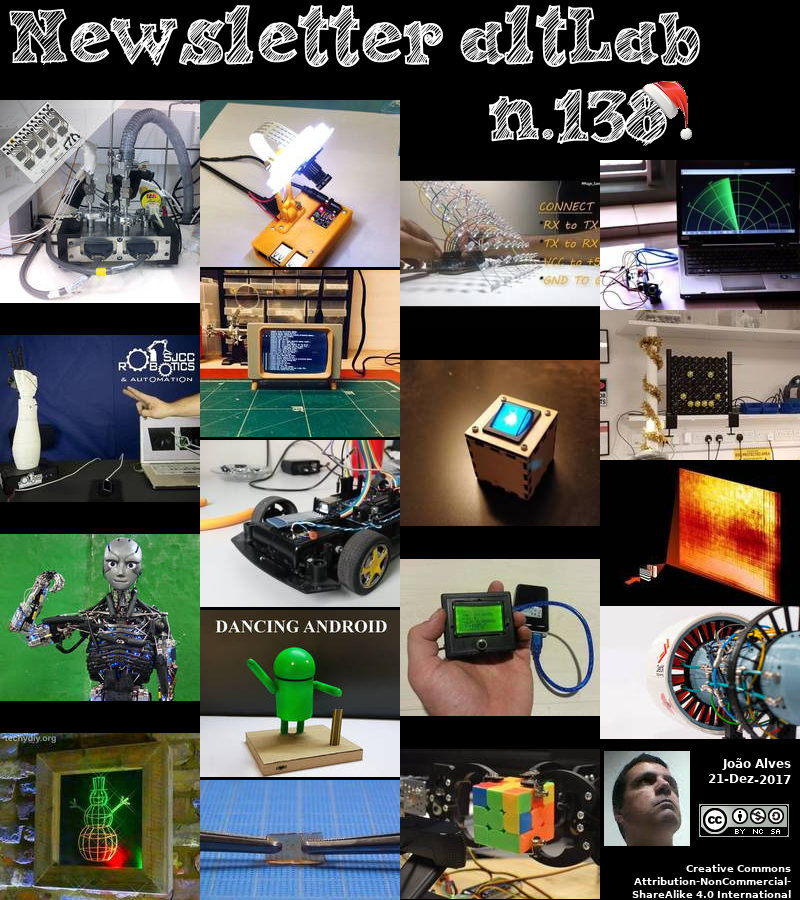
Editorial
Esta é a Newsletter Nº 138 que se apresenta com o mesmo formato que as anteriores. Se gostar da Newsletter partilhe-a!
Todas as Newsletters encontram-se indexadas no link.
Esta Newsletter tem os seguintes tópicos:
Faz hoje anos que nascia, em 1803, Joseph Whitworth. Este engenheiro mecânico inglês, foi pioneiro na medição de precisão. Ele possuía muitas patentes para ferramentas mecânicas, máquinas têxteis e de tricô e máquinas de limpeza rodoviária. Ele criou uma técnica de raspagem para fazer uma superfície verdadeiramente plana. Ele defendeu o uso do sistema decimal. Em 1841, os seus fios de parafuso padrão foram adoptados pelo Woolwich Arsenal. Em 1851, as ferramentas mecânicas da Whitworth eram conhecidas internacionalmente pela sua precisão e qualidade, bem como pelos seus tornos de corte de parafusos, as suas máquinas de planear, perfurar, encaixar e moldar e sua máquina de medição de milionésima parte. Ele também fez um trabalho pioneiro em artilharia, criando um método para moldar aço dúctil para substituir o aço rígido, que está sujeito a fractura.
Faz também anos hoje que nascia, em 1805, Thomas Graham. Este químico e físico escocês é frequentemente chamado de "o pai da química coloidal". Ele estudou a difusão de gases e em 1833 propôs a Lei Graham, que afirmou que a taxa de difusão de um gás é inversamente proporcional à raiz quadrada do peso da sua molécula. Mais tarde, ele estendeu esse trabalho para a difusão de um líquido para outro. Ele classificou solutos em cristalóides (como sal ou açúcar) e colóides (como a goma arábica e as suspensões de ouro finamente divididas de seu colega, Michael Faraday), que marcou o início da química colóide. Ele desenvolveu diálise para separar soluções coloidais de electrólitos. Esta técnica de diálise agora é importante na medicina. Ele também inventou um pêndulo compensado usando uma bolha com um reservatório de mercúrio.
Faz igualmente hoje anos que nascia, em 1841, Victor Schumann. Este físico e espectros-copista alemão, descobriu o ultravioleta de vácuo. Schumann desejava estudar a região "Extreme Ultraviolet". Para isso, ele usou um prisma e lentes em fluorite em vez de quartzo permitindo-se ser o primeiro a medir espectros abaixo de 200 nm. O oxigénio absorveria a radiação com um comprimento de onda inferior a 195 nm, mas Schumann colocou todo o aparelho sob vácuo. Ele preparou suas próprias placas fotográficas com uma camada reduzida de gelatina. Ele publicou na linha de hidrogénio no espectro de Nova Aurigae e no espectro de tubos de vácuo. O seu trabalho abriu o caminho para a espectroscopia de emissão atómica, levando eventualmente à descoberta da série de linhas de espectro de hidrogénio (séries de Lyman) de Theodore Lyman em 1914.
Faz também anos hoje que nascia, em 1878, Jan Łukasiewicz. Este lógico e filósofo polaco nascido em Lwów ficou conhecido pelo seu trabalho na lógica filosófica, na lógica matemática e na história da lógica. Ele pensou de forma inovadora sobre a lógica proposicional tradicional, o princípio da não contradição e a lei do meio excluído. O trabalho moderno sobre a lógica de Aristóteles baseia-se na tradição iniciada em 1951 com o estabelecimento por Łukasiewicz de um paradigma revolucionário. A abordagem Łukasiewicz foi revigorada no início da década de 1970 numa série de trabalhos de John Corcoran e Timothy Smiley - que informam as traduções modernas de Prior Analytics por Robin Smith em 1989 e Gisela Striker em 2009. Łukasiewicz é considerado um dos mais importantes historiadores da lógica.
Por fim, faz anos hoje que nascia, em 1904, Francis Thomas Bacon. Este engenheiro mecânico inglês foi pioneiro nas primeiras células de combustível de hidrogénio-oxigénio modernas, que eletroquimicamente convertem ar e combustível directamente em electricidade. O princípio foi observado por Sir William Grove (1842) quando ele forneceu oxigénio e hidrogénio para eléctrodos de platina imersos em ácido sulfúrico e uma corrente foi produzida num circuito externo. Permaneceu uma curiosidade até Bacon ter iniciado uma pesquisa séria no início da década de 1940 para aplicação em submarinos. Em 1959, ele desenvolveu uma célula de combustível bem sucedida de seis quilowatts. Quando as células de combustível foram usadas por veículos espaciais Apollo dos EUA, forneciam energia em voo e água potável, o subproduto da reacção electroquímica.
Esta semana ficámos a saber que o X Lab da Alphabet, de acordo com um relatório da Reuters, preparou mais um outra forma de conectividade com a Internet. Os esforços anteriores envolveram balões flutuantes de Internet e colocando muitos cabos de fibra óptica, mas este sistema de entrega de Internet envia dados sobre feixes de laser! Este não é um sistema experimental como Project Loon; O governo do estado da Índia, Andhra Pradesh, assinou um acordo com a Alphabet para levar a tecnologia a milhões de pessoas a partir do próximo ano. A tecnologia é chamada de "comunicação óptica de espaço livre", e funciona exactamente da maneira como ela soa: aponta-se dois feixes de luz um para o outro e comunica-se através de piscar. "Espaço livre" significa que não se está a usar nenhum cabo e está apenas se comunicando através do ar ao longo da linha de visão. Normalmente isso é feito com laseres, embora para distâncias mais curtas seja possível usar LEDs.
Há muitos robôs que procuram humanóides, mas muito poucos realmente possuem corpos particularmente análogos aos nossos quando se trata de mover e interagir com o meio ambiente. Pesquisadores japoneses estão trabalhando para ultrapassar essa limitação com um robô projectado especificamente para imitar não apenas os movimentos humanos, mas a maneira como os humanos realmente realizam esses movimentos, até suando. Kengoro é um novo robô que enfatiza a flexibilidade e a verdadeira estrutura humanóide ao invés de colocar o poder ou a eficiência acima de tudo.
Na Newsletter desta semana apresentamos diversos projetos de maker. São apresentados igualmente as revistas MagPI nº 65, a newselectronics de 12 de Dezembro e a Hackspace Nº2.
Aproveitamos para desejar votos de boas festas a todos!
 João Alves ([email protected])
João Alves ([email protected])
O conteúdo da Newsletter encontra-se sob a licença  Creative Commons Attribution-NonCommercial-ShareAlike 4.0 International License.
Creative Commons Attribution-NonCommercial-ShareAlike 4.0 International License.
Novidades da Semana
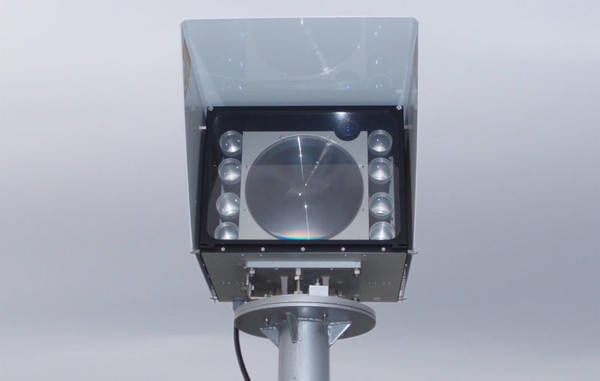
Alphabet wants to deliver Internet access via laser beams
"Alphabet's X Lab has cooked up yet another Internet connectivity scheme, according to a report from Reuters. Past efforts have involved floating Internet balloons and laying lots of fiber optic cable, but this Internet delivery system sends data over laser beams! This isn't an experimental system like Project Loon; India’s Andhra Pradesh state government has signed an agreement with Alphabet to bring the technology to millions of people starting next year. The technology is called "free space optical communication," and it works exactly the way it sounds: you aim two light beams at each other and communicate through blinking. "Free space" means you're not using any cable at all and are just communicating through the air over line of sight. Typically this is done with lasers, although for shorter distances it's possible to use LEDs." [...]
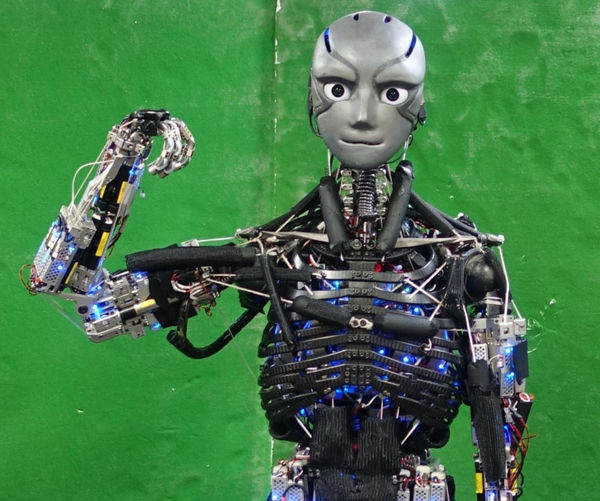
This humanoid robot works out (and sweats) like we do (or should)
"There are plenty of humanoid-looking robots out there, but very few actually have bodies that are particularly analogous to our own when it comes to moving and interacting with the environment. Japanese researchers are working to remedy that with a robot designed specifically to mimic not just human movements but the way humans actually accomplish those movements. Oh, and it sweats. Kengoro is a new-ish robot (an earlier version made the rounds last year) that emphasizes flexibility and true humanoid structure rather than putting power or efficiency above all else. As the researchers explain in their paper, published today in Science Robotics: A limitation of conventional humanoids is that they have been designed on the basis of the theories of conventional engineering, mechanics, electronics, and informatics. By contrast, our intent is to design a humanoid based on human systems — including the musculoskeletal structure, sensory nervous system, and methods of information processing in the brain — to support science-oriented goals, such as gaining a deeper understanding of the internal mechanisms of humans." [...]
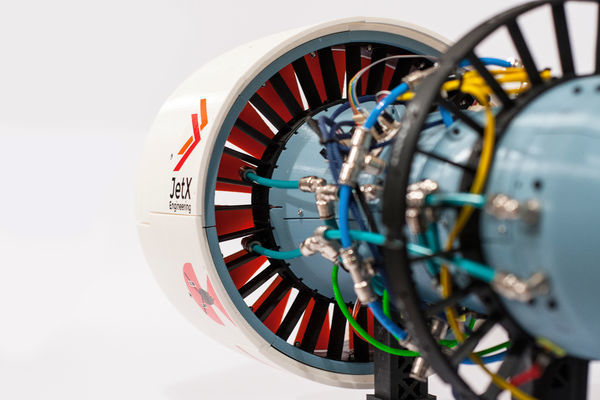
Rolls Royce is working with this student team to create a functional 3D printed jet engine model
"There's a shortage of engineering students and in STEM subjects generally. Whether its developing rockets to Mars, the new future of public transport or a bridge, society needs engineers to make it happen. This team of students are looking to fix this shortage by getting more potential engineers involved and interested in this field. 3D Hubs Student Grant finalist JetX are a team of aerospace engineering students working with Rolls Royce to create the world's first functional 3D printed jet engine model that will provide instant design feedback and show people studying engineering doesn't mean your glued to a textbook. The project started back in 2013 at the University of Glasgow when Chris Triantafyllou the President and Founder of JetX spotted the need for more hands on learning to get people engaged with the subject. Alongside this he saw two important skills for future engineers to master but with no outlet to gain direct experience: Design for assembly Simulation analysis By building such an ambitious project and working with Rolls Royce, JetX hopes to show that engineering isn't just writing down theorems and mathematical equations but about making a real impact with the work you do." [...]
Outras Notícias

SpaceX Launches (and Lands) Used Rocket on Historic NASA Cargo Mission
"SpaceX launched and landed a used rocket today (Dec. 15), pulling off yet another spaceflight double play during a delivery mission for NASA that gets the company a big step closer to its goal of complete reusability. SpaceX's two-stage Falcon 9 rocket lifted off today at 10:36 a.m. EST (1536 GMT) from Cape Canaveral Air Force Station in Florida, sending the company's robotic Dragon capsule on a resupply run to the International Space Station (ISS) that just might include some Christmas presents for the station’s crew. Both the rocket and its payload have previous spaceflight experience: This Dragon visited the orbiting lab back in April 2015, and the Falcon 9 first stage launched a different Dragon toward the ISS in June 2017. Never before had SpaceX launched a pre-flown spacecraft atop a pre-flown rocket — and never before had the company employed a used rocket on a cargo mission for NASA. The agency approved the use of a pre-flown booster after conducting an extensive review of the risks involved, NASA officials said. "We're very comfortable that the risk posture on this vehicle is not significantly greater than [on] a new booster," Kirk Shireman, NASA's ISS program manager, said in a prelaunch briefing Monday (Dec. 11)." [...]

Intel Unveils Industry’s First FPGA Integrated with High Bandwidth Memory Built for Acceleration
"Intel today announced the availability of the Intel® Stratix® 10 MX FPGA, the industry’s first field programmable gate array (FPGA) with integrated High Bandwidth Memory DRAM (HBM2). By integrating the FPGA and the HBM2, Intel Stratix 10 MX FPGAs offer up to 10 times the memory bandwidth when compared with standalone DDR memory solutions1. These bandwidth capabilities make Intel Stratix 10 MX FPGAs the essential multi-function accelerators for high-performance computing (HPC), data centers, network functions virtualization (NFV), and broadcast applications that require hardware accelerators to speed-up mass data movements and stream data pipeline frameworks. In HPC environments, the ability to compress and decompress data before or after mass data movements is paramount. HBM2-based FPGAs can compress and accelerate larger data movements compared with stand-alone FPGAs. With High Performance Data Analytics (HPDA) environments, streaming data pipeline frameworks like Apache* Kafka and Apache* Spark Streaming require real-time hardware acceleration." [...]

Mbed OS 5.7 released: Focus on robustness, connectivity and ease of use
"The Arm Mbed OS 5.7.0 release helps to further simplify the Internet of Things (IoT) and embedded product development with the addition of several new features, such as the high-integrity embedded file system, which provides power loss resilient operation and maximizes the life of the external memory block device by implementing wear leveling techniques. The release also includes an open-source mesh networking stack, which is IPv6, 6LoWPAN and one of the only two open-source certified Thread networking stacks. This release also continues our efforts to add comprehensive documentation for Mbed OS. Our ongoing efforts in this area include adding documentation about contributing and using our platform, drivers, RTOS, connectivity and storage APIs, as well as information about our tools. This release also includes improvements to the user experience of our documentation. In addition, this release contains many minor fixes and enhancements and brings support for 103 target development boards." [...]

Samsung Now Mass Producing Industry’s First 2nd-generation, 10-Nanometer Class DRAM
"Samsung Electronics, the world leader in advanced memory technology, announced today that it has begun mass producing the industry’s first 2nd-generation of 10-nanometer class* (1y-nm), 8-gigabit (Gb) DDR4 DRAM. For use in a wide range of next-generation computing systems, the new 8Gb DDR4 features the highest performance and energy efficiency for an 8Gb DRAM chip, as well as the smallest dimensions. “By developing innovative technologies in DRAM circuit design and process, we have broken through what has been a major barrier for DRAM scalability,” said Gyoyoung Jin, president of Memory Business at Samsung Electronics. “Through a rapid ramp-up of the 2nd-generation 10nm-class DRAM, we will expand our overall 10nm-class DRAM production more aggressively, in order to accommodate strong market demand and continue to strengthen our business competitiveness.” Samsung’s 2nd-generation 10nm-class 8Gb DDR4 features an approximate 30 percent productivity gain over the company’s 1st–generation 10nm-class 8Gb DDR4. In addition, the new 8Gb DDR4’s performance levels and energy efficiency have been improved about 10 and 15 percent respectively, thanks to the use of an advanced, proprietary circuit design technology. The new 8Gb DDR4 can operate at 3,600 megabits per second (Mbps) per pin, compared to 3,200 Mbps of the company’s 1x-nm 8Gb DDR4." [...]
Ciência e Tecnologia
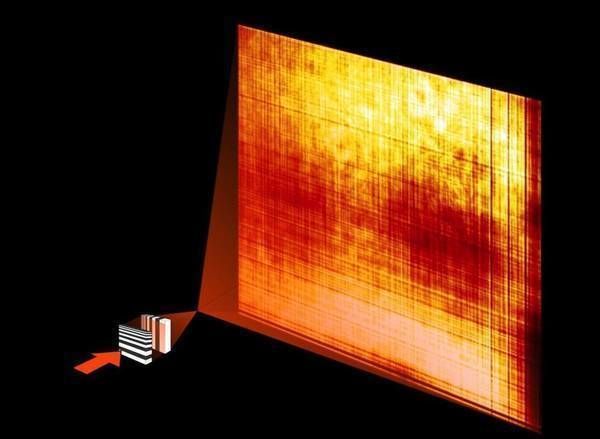
Novel lenses enable X-ray microscopy with record resolution
"Scientists at DESY have developed novel lenses that enable X-ray microscopy with record resolution in the nanometre regime. Using new materials, the research team led by DESY scientist Saša Bajt from the Center for Free-Electron Laser Science (CFEL) has perfected the design of specialised X-ray optics and achieved a focus spot size with a diameter of less than ten nanometres. A nanometre is a millionths of a millimetre and is smaller than most virus particles. The researchers report their work in the journal Light: Science and Applications. They successfully used their lenses to image samples of marine plankton. Modern particle accelerators provide ultra-bright and high-quality X-ray beams." [...]
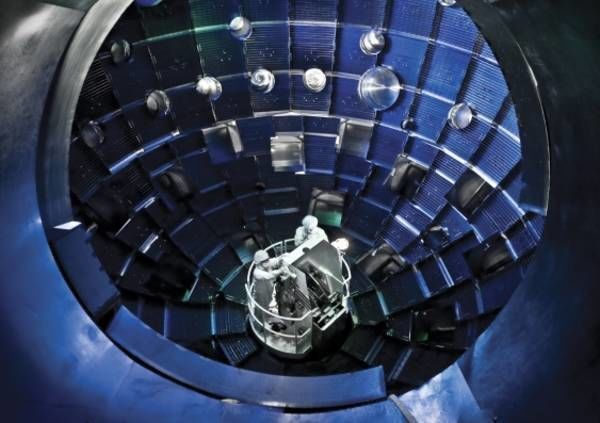
Laser-boron fusion now ‘leading contender’ for energy
"A laser-driven technique for creating fusion that dispenses with the need for radioactive fuel elements and leaves no toxic radioactive waste is now within reach, says a UNSW physicist. A laser-driven technique for creating fusion that dispenses with the need for radioactive fuel elements and leaves no toxic radioactive waste is now within reach, say researchers. Dramatic advances in powerful, high-intensity lasers are making it viable for scientists to pursue what was once thought impossible: creating fusion energy based on hydrogen-boron reactions. And an Australian physicist is in the lead, armed with a patented design and working with international collaborators on the remaining scientific challenges. In a paper in the scientific journal Laser and Particle Beams, lead author Heinrich Hora from UNSW Sydney and international colleagues argue that the path to hydrogen-boron fusion is now viable, and may be closer to realisation than other approaches, such as the deuterium-tritium fusion approach being pursued by US National Ignition Facility (NIF) and the International Thermonuclear Experimental Reactor under construction in France. “I think this puts our approach ahead of all other fusion energy technologies,” said Hora, who predicted in the 1970s that fusing hydrogen and boron might be possible without the need for thermal equilibrium." [...]
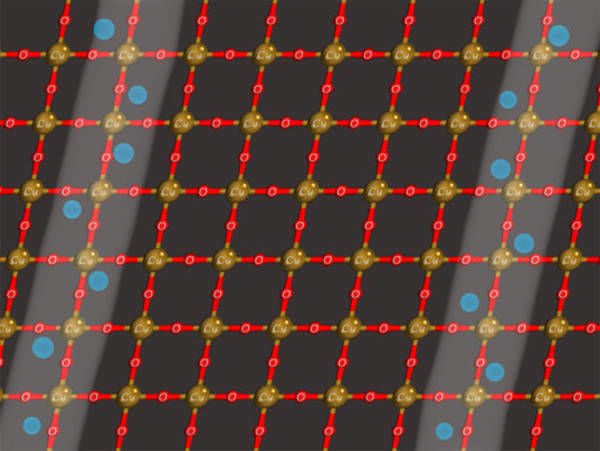
Stripes May Help Solve Riddle of Superconductivity
"Imagine phones and laptops that never heat up or power grids that never lose energy. This is the dream of scientists working with so-called high-temperature superconductors, which can effortlessly carry electrical currents with no resistance. The first high-temperature superconducting materials, called cuprates, were discovered in the 1980s and would later be the subject of a Nobel Prize. The term "high-temperature" is relative—these materials operate at frosty temperatures of up to minus 135 degrees Celsius, a bit higher than their traditional counterparts, which work at even chillier temperatures near absolute zero (minus 273 degrees Celsius). Despite the fact that high-temperature superconductors were discovered three decades ago, researchers are still scratching their heads over how the materials work. Scientists know that the answer is related to electrons sticking together in pairs, as if glued together, but the nature of the electron "glue" that binds them is unknown." [...]

Robotics researchers track autonomous underground mining vehicles
"QUT robotics researchers have developed new technology to equip underground mining vehicles to navigate autonomously through dust, camera blur and bad lighting. Using mathematics and biologically-inspired algorithms, the technology uses vehicle-mounted cameras to track the location of the vehicle in underground tunnels to within metres. The research has been led by a team from the Australian Centre for Robotic Vision at QUT, including Professor Michael Milford in collaboration with Catepillar, Mining3 and the Queensland Government. Autonomous vehicles are increasingly used in the underground mining industry Machinery needs to navigate through harsh environment and maze of tunnels Mine operators are using costly sensing or infrastructure modifications New positioning tech increases efficiency and safety underground Professor Milford said autonomous vehicles operating in underground mines relied on expensive sensing or infrastructure modifications. “This is stage one of the project,” he said. “It’s commercially important to be able to track the location of all your mobile assets in an underground mine, especially if you can do it cheaply without needing to install extra infrastructure or use expensive laser sensing.” “We have developed a positioning system that uses cameras rather than lasers, based on more than a decade of research in biologically-inspired navigation technology.” The tough terrain means Global Positioning Systems cannot be used and Wireless Sensor Networks are less reliable due to interference from the rock mass and lack of access points." [...]
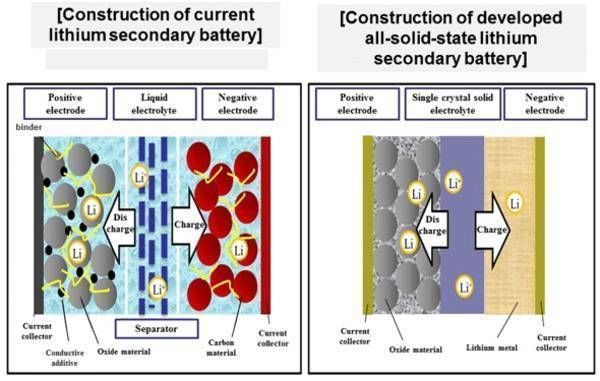
European satellite confirms general relativity with unprecedented precision
"A space mission to test how objects fall in a vacuum has released its first results, providing an improved foundation for Einstein's famous theory. The first results of the ‘Microscope’ satellite mission were announced this week by a group of researchers led by the French space agency CNES and including Imperial scientists. The findings are published in the journal Physical Review Letters. Launched in April 2016, the mission set out to test the ‘equivalence principle’, the founding assumption of Einstein’s theory of general relativity. The theory poses that gravity is not a ‘pulling’ force, but is the result of large bodies, like the Earth, bending spacetime. As a result, when two objects are dropped in a vacuum under the same force of gravity, they fall at the same rate, no matter what their difference in weight or composition." [...]
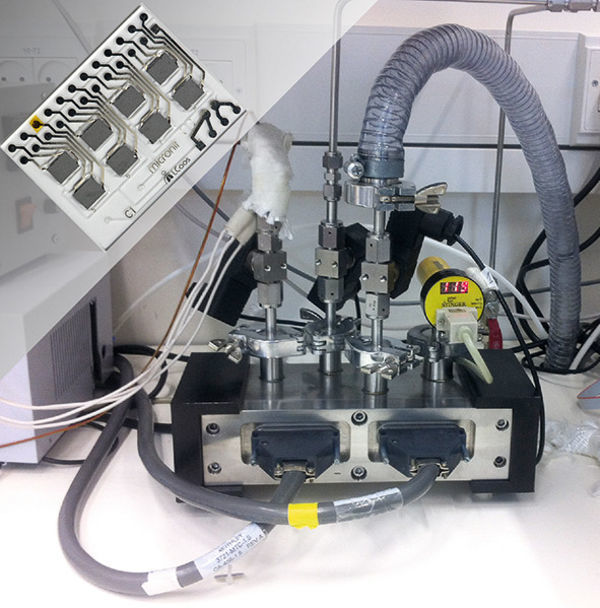
A chip for environmental and health monitoring
"In a joint German-Israeli research project, FAU scientists are developing miniaturised sensor systems that can be produced on an industrial scale Sensors for incorporation in inexpensive measuring devices or virtual personal support systems are increasingly in demand in the environmental, safety, and health-monitoring fields. To date, however, progress has been hampered because the cost-effective manufacturing processes necessary for mass production are lacking. Researchers at FAU with international partners from Israel and Germany have set about changing this in a project funded by the German Federal Ministry of Education and Research. If the project is successful, the sensors could in future be used for large-scale close monitoring of NO2 levels in metropolitan areas and to improve the diagnosis and early detection of cancers. Combining different sensor components is a key factor The project represents an extension of an earlier successful collaborative undertaking in which the Erlangen-based team developed the technological groundwork together with their Israeli colleagues. These include intelligent sensor arrays, which can analyse complex gas mixtures." [...]
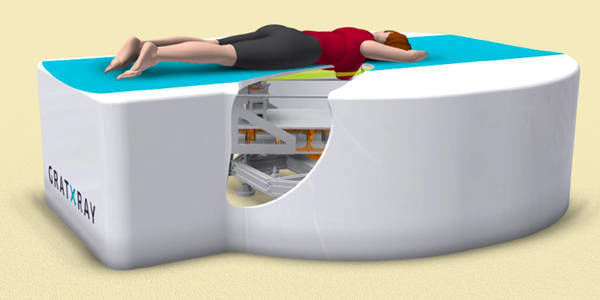
X-ray light revolutionaries
"The ETH spin-off GratXray is working to improve precision in mammography. With the help of an innovative new device, breast cancer detection might not only become more accurate, but also painless. This is a revolutionary step in breast screening. Every start-up begins with a vision of conquering the market with new ideas, but a number of milestones must first be reached before the successful founding of a company. This was the case for GratXray, a spin-off that grew out of ETH Zurich and the Paul-Scherrer Institute (PSI) this summer. Grating is the key “There’s a fairly long story behind the founding of GratXray,” says Marco Stampanoni, co-founder of the spin-off and professor of X-ray imaging at ETH Zurich." [...]
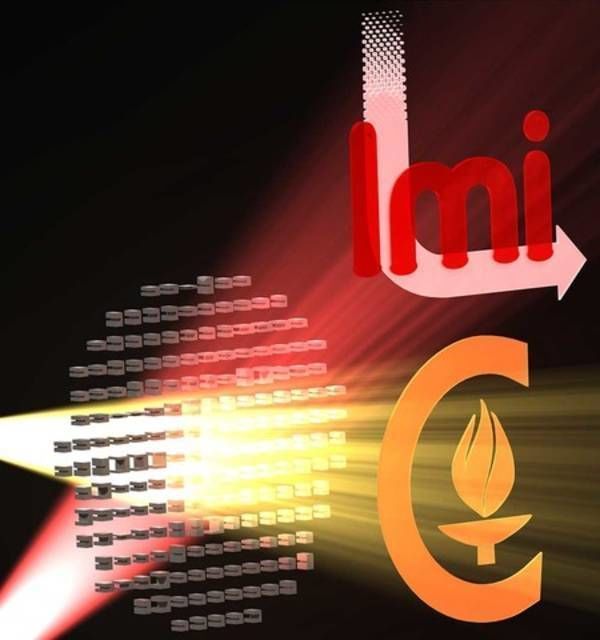
Two Holograms in One Surface
"A team at Caltech has figured out a way to encode more than one holographic image in a single surface without any loss of resolution. The engineering feat overturns a long-held assumption that a single surface could only project a single image regardless of the angle of illumination. The technology hinges on the ability of a carefully engineered surface to reflect light differently depending on the angle at which incoming light strikes that surface. Holograms are three-dimensional images encoded in two-dimensional surfaces. When the surface is illuminated with a laser, the image seems to pop off the surface and becomes visible. Traditionally, the angle at which laser light strikes the surface has been irrelevant—the same image will be visible regardless." [...]

Hyperlens crystal capable of viewing living cells in unprecedented detail
"Just imagine: An optical lens so powerful that it lets you view features the size of a small virus on the surface of a living cell in its natural environment. Construction of instruments with this capability is now possible because of a fundamental advance in the quality of an optical material used in hyperlensing, a method of creating lenses that can resolve objects much smaller than the wavelength of light. The achievement was reported by a team of researchers led by Joshua Caldwell, associate professor of mechanical engineering at Vanderbilt University, in a paper published Nov. 11 in the journal Nature Materials. The optical material involved is hexagonal boron nitride (hBN), a natural crystal with hyperlensing properties. The best previously reported resolution using hBN was an object about 36 times smaller than the infrared wavelength used: about the size of the smallest bacteria. The new paper describes improvements in the quality of the crystal that enhance its potential imaging capability by about a factor of ten." [...]

The Great AI Paradox
"Don’t worry about supersmart AI eliminating all the jobs. That’s just a distraction from the problems even relatively dumb computers are causing. You’ve probably heard versions of each of the following ideas. 1. With computers becoming remarkably adept at driving, understanding speech, and other tasks, more jobs could soon be automated than society is prepared to handle. 2." [...]

Carnegie Mellon Reveals Inner Workings of Victorious AI
"Libratus, an artificial intelligence that defeated four top professional poker players in no-limit Texas Hold'em earlier this year, uses a three-pronged approach to master a game with more decision points than atoms in the universe, researchers at Carnegie Mellon University report. In a paper published online today by the journal Science, Tuomas Sandholm, professor of computer science, and Noam Brown, a Ph.D. student in the Computer Science Department, detail how their AI achieved superhuman performance by breaking the game into computationally manageable parts and, based on its opponents' game play, fix potential weaknesses in its strategy during the competition. AI programs have defeated top humans in checkers, chess and Go — all challenging games, but ones in which both players know the exact state of the game at all times. Poker players, by contrast, contend with hidden information: what cards their opponents hold and whether an opponent is bluffing. In a 20-day competition involving 120,000 hands at Rivers Casino in Pittsburgh this past January, Libratus became the first AI to defeat top human players at Head's-Up, No-Limit Texas Hold'em — the primary benchmark and longstanding challenge problem for imperfect-information game-solving by AIs. Libratus beat each of the players individually in the two-player game and collectively amassed more than $1.8 million in chips." [...]

Computer systems predict objects’ responses to physical forces
"Josh Tenenbaum, a professor of brain and cognitive sciences at MIT, directs research on the development of intelligence at the Center for Brains, Minds, and Machines, a multiuniversity, multidisciplinary project based at MIT that seeks to explain and replicate human intelligence. Presenting their work at this year’s Conference on Neural Information Processing Systems, Tenenbaum and one of his students, Jiajun Wu, are co-authors on four papers that examine the fundamental cognitive abilities that an intelligent agent requires to navigate the world: discerning distinct objects and inferring how they respond to physical forces. By building computer systems that begin to approximate these capacities, the researchers believe they can help answer questions about what information-processing resources human beings use at what stages of development. Along the way, the researchers might also generate some insights useful for robotic vision systems. “The common theme here is really learning to perceive physics,” Tenenbaum says. “That starts with seeing the full 3-D shapes of objects, and multiple objects in a scene, along with their physical properties, like mass and friction, then reasoning about how these objects will move over time." [...]
Complete design of a silicon quantum computer chip unveiled
"A reimagining of today’s computer chips by UNSW engineers shows how a quantum computer can be manufactured – using mostly standard silicon technology. A reimagining of today’s computer chips by Australian and Dutch engineers shows how a quantum computer can be manufactured – using mostly standard silicon technology. Research teams all over the world are exploring different ways to design a working computing chip that can integrate quantum interactions. Now, UNSW engineers believe they have cracked the problem, reimagining the silicon microprocessors we know to create a complete design for a quantum computer chip that can be manufactured using mostly standard industry processes and components. The new chip design, published in the journal Nature Communications, details a novel architecture that allows quantum calculations to be performed using existing semiconductor components, known as CMOS (complementary metal-oxide-semiconductor) – the basis for all modern chips. It was devised by Andrew Dzurak, director of the Australian National Fabrication Facility at the University of New South Wales (UNSW), and Menno Veldhorst, lead author of the paper who was a research fellow at UNSW when the conceptual work was done." [...]
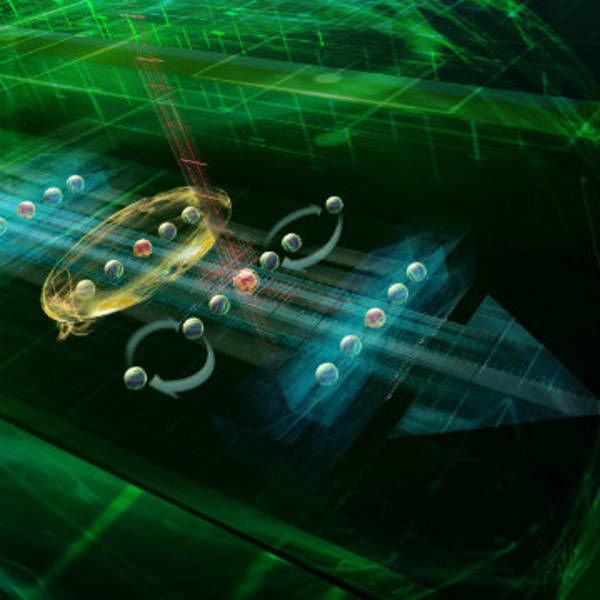
Error-free into the Quantum Computer Age
"A study led by physicists at Swansea University in Wales, carried out by an international team of researchers and published in the journal Physical Review X shows that ion-trap technologies available today are suitable for building large-scale quantum computers. The scientists introduce trapped-ion quantum error correction protocols that detect and correct processing errors. In order to reach their full potential, today’s quantum computer prototypes have to meet specific criteria: First, they have to be made bigger, which means they need to consist of a considerably higher number of quantum bits. Second, they have to be capable of processing errors. “We still fail in running complex computations because environmental noise and errors cause the system to get out of control,” says quantum physicist Rainer Blatt in Innsbruck. “By using quantum error correction, we can respond to this challenge better.” Classical computers use similar schemes to detect and correct errors during data storage and transfer: Before data is stored and transferred, redundancy is added to the data usually in the form of additional bits detecting and correcting errors." [...]
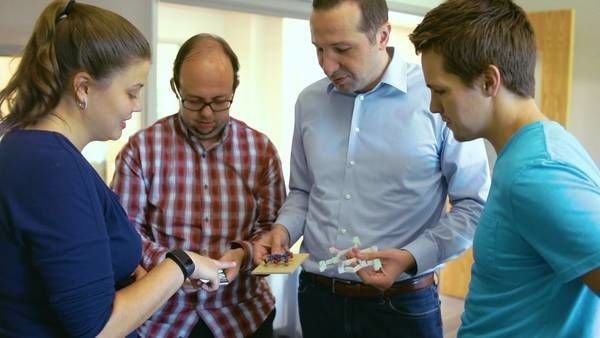
Building 3-D models of molecules with RealityConvert
"Denis Fourches wants to make the search for new drugs faster and less expensive. So he uses powerful computers to help model interactions between chemical compounds and biological targets to predict the compound’s effectiveness, thus narrowing the field of potential drug candidates for testing and saving researchers time and money. Now he has a new tool in his arsenal – a computer program that will allow anyone to rapidly create three-dimensional models of molecules for 3-D printing as well as augmented and virtual reality applications, making it easier to study these complex biomolecular structures. “Large and complex biomolecules like proteins make it difficult for researchers and students to accurately visualize their structure or how they might interact with a given compound,” says Fourches, assistant professor of chemistry at NC State. “But if we can easily build an accurate 3-D model of the protein into a virtual reality or augmented reality environment, we can enable a much better perception of the geometrical and structural characteristics of that molecule.” RealityConvert is a software tool that converts molecular objects – such as proteins and drugs – to high quality 3-D models. It generates 3-D molecular and biomolecular models in standard file formats that are compatible with the vast majority of augmented and virtual reality programs as well as 3-D printing tools." [...]
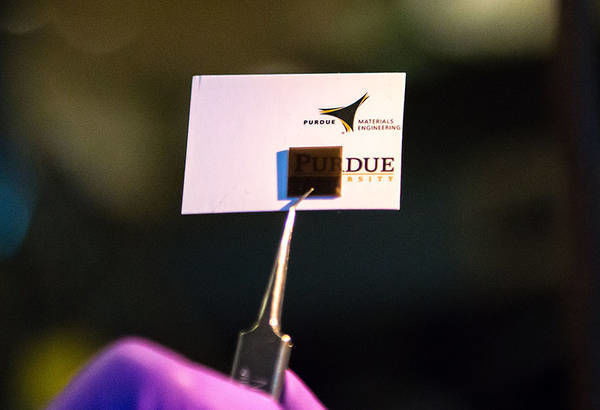
‘Quantum material’ has shark-like ability to detect small electrical signals
"A “quantum material” that mimics a shark’s ability to detect the minute electric fields of small prey has been shown to perform well in ocean-like conditions, with potential applications from defense to marine biology. The material maintains its functional stability and does not corrode after being immersed in saltwater, a prerequisite for ocean sensing. Surprisingly, it also functions well in the cold, ambient temperatures typical of seawater, said Shriram Ramanathan, a Purdue professor of materials engineering. Such a technology might be used to study ocean organisms and ecosystems and to monitor the movement of ships for military and commercial maritime applications. “So, it has potentially very broad interest in many disciplines,” said Ramanathan, who led research to develop the sensor, working with a team that included Purdue postdoctoral research associate Zhen Zhang and graduate student Derek Schwanz. Findings are detailed in a research paper appearing online Dec. 18 in the journal Nature." [...]

Scientists Engineer Nanoscale Pillars to Act Like Memory Foam
"New organic-inorganic hybrid materials exhibit an unprecedented combination of strength and elasticity, paving the way to new nanoelectromechanical devices A team of scientists from the U.S. Department of Energy’s Brookhaven National Laboratory and the University of Connecticut have developed a customizable nanomaterial that combines metallic strength with a foam-like ability to compress and spring back. “We engineered materials that can store and release an unprecedented amount of mechanical energy on the nanoscale—for its weight, one of the highest ever among known high-strength engineering materials,” said Brookhaven Lab scientist and principal investigator Chang-Yong Nam. “And our technique fits into existing industrial semiconductor processes, which means the jump from the lab to practical applications should be straightforward.” The study, published on October 19 in the journal Nano Letters, describes nanostructures spanning just a few billionths of a meter in size composed of organic and inorganic molecules. These custom-patterned structures—like the pillars explored in this study—will enable more advanced nanoelectromechanical systems (NEMS), for example in devices that require ultra-small springs, levers, or motors. NEMS technology that could potentially exploit this new material includes ultrasensitive accelerometers, multi-functional resonators, and biosynthetic artificial muscles. “The breakthrough relied on us developing the synthesis,” Nam added." [...]
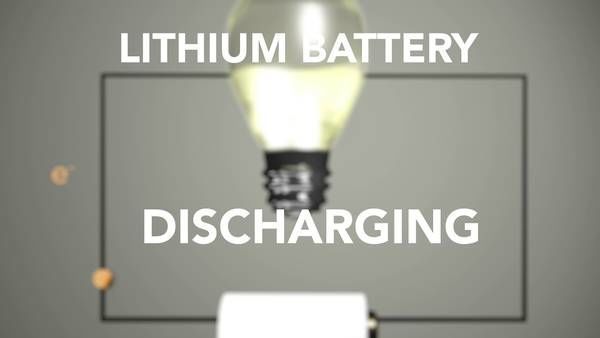
Scientists Discover Path to Improving Game-Changing Battery Electrode
"Electric car makers are intensely interested in lithium-rich battery cathodes that could significantly increase driving range. A new study opens a path to making them live up to their promise. If you add more lithium to the positive electrode of a lithium-ion battery – overstuff it, in a sense – it can store much more charge in the same amount of space, theoretically powering an electric car 30 to 50 percent farther between charges. But these lithium-rich cathodes quickly lose voltage, and years of research have not been able to pin down why – until now. After looking at the problem from many angles, researchers from Stanford University, two Department of Energy national labs and the battery manufacturer Samsung created a comprehensive picture of how the same chemical processes that give these cathodes their high capacity are also linked to changes in atomic structure that sap performance. “This is good news,” said William E. Gent, a Stanford University graduate student and Siebel Scholar who led the study." [...]

Reducing the traffic jam in batteries
"Research at Sandia National Laboratories has identified a major obstacle to advancing solid-state lithium-ion battery performance in small electronics: the flow of lithium ions across battery interfaces. Sandia’s three-year Laboratory Directed Research and Development project investigated the nanoscale chemistry of solid-state batteries, focusing on the region where electrodes and electrolytes make contact. Most commercial lithium-ion batteries contain a liquid electrolyte and two solid electrodes, but solid-state batteries instead have a solid electrolyte layer, allowing them to last longer and operate more safely. “The underlying goal of the work is to make solid-state batteries more efficient and to improve the interfaces between different materials,” Sandia physicist Farid El Gabaly said. “In this project, all of the materials are solid; we don’t have a liquid-solid interface like in traditional lithium-ion batteries.” The research was published in a Nano Letters paper titled, “Non-Faradaic Li+ Migration and Chemical Coordination across Solid-State Battery Interfaces.” Authors include Sandia postdoctoral scientist Forrest Gittleson and El Gabaly. The work was funded by the Laboratory Directed Research and Development program, with supplemental funding by the Department of Energy’s Office of Science." [...]
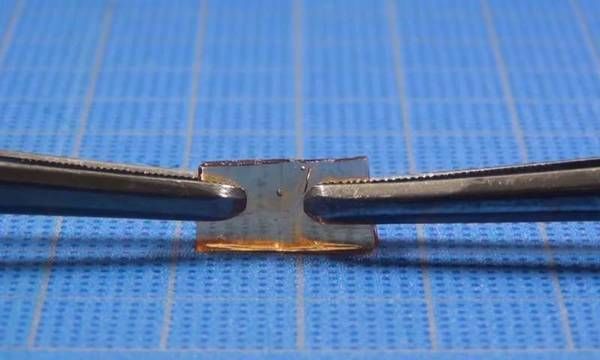
A type of semi-transparent polymer that can be mended at room temperature using small pressure
"A small team of researchers at the University of Tokyo has created a polymer that can be repaired when broken into two parts by applying a small amount of pressure at room temperature. In their paper published in the journal Science, the group describes how they came upon the polymer, how it was made, and how well it can be repaired. Engineers around the world have been working hard to find a type of glass or plastic that can be healed easily when broken to address the problem of broken screens on phones and other portable devices. While some progress has been made, there still exists a need for something better. In this new effort, the researchers report on a new type of plastic that can be healed by simply pressing the broken pieces back together. As the researchers describe it, a team member was investigating glue properties with polymers when they discovered that one of the polymers under study could mend itself just by pushing the pieces together." [...]
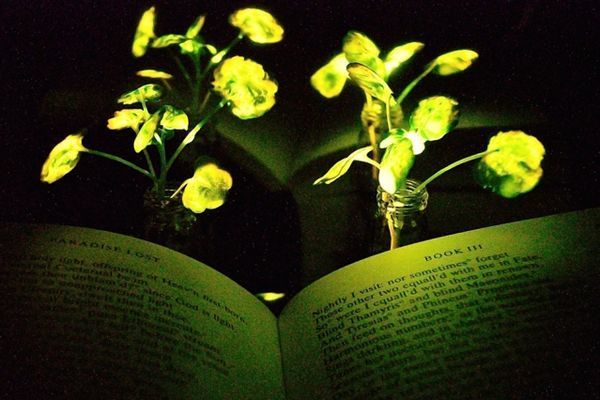
Engineers create plants that glow
"Imagine that instead of switching on a lamp when it gets dark, you could read by the light of a glowing plant on your desk. MIT engineers have taken a critical first step toward making that vision a reality. By embedding specialized nanoparticles into the leaves of a watercress plant, they induced the plants to give off dim light for nearly four hours. They believe that, with further optimization, such plants will one day be bright enough to illuminate a workspace. “The vision is to make a plant that will function as a desk lamp — a lamp that you don’t have to plug in. The light is ultimately powered by the energy metabolism of the plant itself,” says Michael Strano, the Carbon P. Dubbs Professor of Chemical Engineering at MIT and the senior author of the study." [...]

‘Negative capacitance’ could bring more efficient transistors
"Researchers have experimentally demonstrated how to harness a property called negative capacitance for a new type of transistor that could reduce power consumption, validating a theory proposed in 2008 by a team at Purdue University. The researchers used an extremely thin, or 2-D, layer of the semiconductor molybdenum disulfide to make a channel adjacent to a critical part of transistors called the gate. Then they used a “ferroelectric material” called hafnium zirconium oxide to create a key component in the newly designed gate called a negative capacitor. Capacitance, or the storage of electrical charge, normally has a positive value. However, using the ferroelectric material in a transistor’s gate allows for negative capacitance, which could result in far lower power consumption to operate a transistor. Such an innovation could bring more efficient devices that run longer on a battery charge." [...]
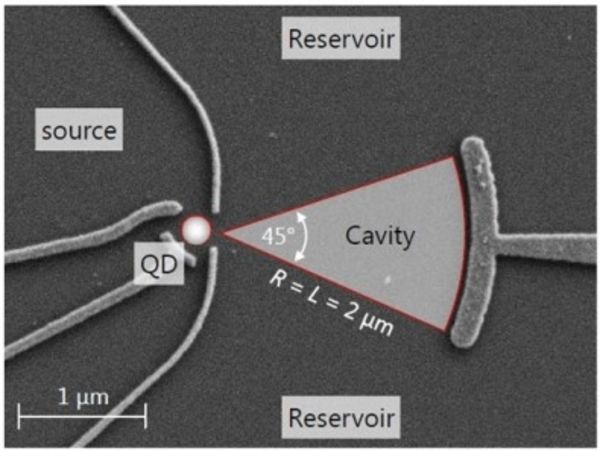
Quantum effects explain changes in nanometric circuit electron flows
"Transistors capable of functioning with an electrical current consisting of the passage of a single electron at each point in time are on the horizon for research in the field of information technology. By associating the 0/1 binary with electron transit or non-transit, the device can drastically improve space usage and reduce power consumption in future computers. This option is not yet economically feasible, but it already exists in the laboratory. An experiment with a device of this kind performed in 2015 at ETH Zürich, the Swiss Federal Institute of Technology in Zurich, raised theoretical issues that have now been resolved by a group of researchers comprising Luis Gregório Dias da Silva (University of São Paulo, USP, Brazil), Caio Lewenkopf (Fluminense Federal University, Brazil), Edson Vernek (USP), Gerson Ferreira Júnior (Federal University of Uberlândia, Brazil) and Sergio Ulloa (Ohio University, USA). A paper by this group, which is supported by FAPESP, has been published in Physical Review Letters. “The object studied was a nanometric circuit in which electron transmission from one part to another undergoes quantum effects owing to its very small scale." [...]
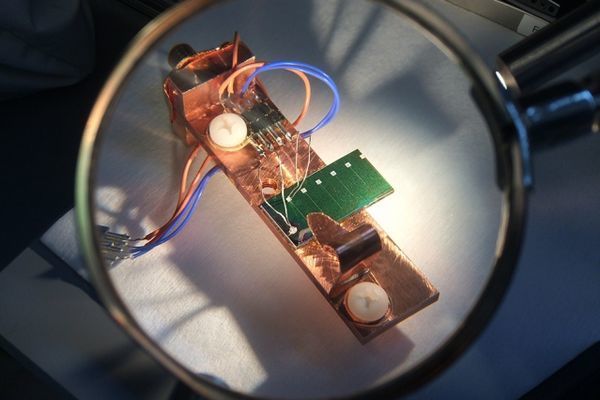
New technique allows rapid screening for new types of solar cells
"Approach could bypass the time-consuming steps currently needed to test new photovoltaic materials. The worldwide quest by researchers to find better, more efficient materials for tomorrow’s solar panels is usually slow and painstaking. Researchers typically must produce lab samples — which are often composed of multiple layers of different materials bonded together — for extensive testing. Now, a team at MIT and other institutions has come up with a way to bypass such expensive and time-consuming fabrication and testing, allowing for a rapid screening of far more variations than would be practical through the traditional approach. The new process could not only speed up the search for new formulations, but also do a more accurate job of predicting their performance, explains Rachel Kurchin, an MIT graduate student and co-author of a paper describing the new process that appears this week in the journal Joule. Traditional methods “often require you to make a specialized sample, but that differs from an actual cell and may not be fully representative” of a real solar cell’s performance, she says." [...]

World Record: Quantum Computer with 46 Qubits simulated
"Scientists from the Jülich Supercomputing Centre have set a new world record. Together with researchers from Wuhan University and the University of Groningen, they successfully simulated a quantum computer with 46 quantum bits – or qubits – for the first time. For their calculations, the scientists used the Jülich supercomputer JUQUEEN as well as the world’s fastest supercomputer Sunway TaihuLight at China’s National Supercomputing Center in Wuxi. Software developers won’t have to start from scratch when the first practically applicable quantum computers become available in future. It is today possible to simulate the functioning of relatively large quantum computers on classical digital computers. The computational effort involved, however, is enormous." [...]
Complete design of a silicon quantum computer chip unveiled
"A reimagining of today’s computer chips by UNSW engineers shows how a quantum computer can be manufactured – using mostly standard silicon technology. A reimagining of today’s computer chips by Australian and Dutch engineers shows how a quantum computer can be manufactured – using mostly standard silicon technology. Research teams all over the world are exploring different ways to design a working computing chip that can integrate quantum interactions. Now, UNSW engineers believe they have cracked the problem, reimagining the silicon microprocessors we know to create a complete design for a quantum computer chip that can be manufactured using mostly standard industry processes and components. The new chip design, published in the journal Nature Communications, details a novel architecture that allows quantum calculations to be performed using existing semiconductor components, known as CMOS (complementary metal-oxide-semiconductor) – the basis for all modern chips. It was devised by Andrew Dzurak, director of the Australian National Fabrication Facility at the University of New South Wales (UNSW), and Menno Veldhorst, lead author of the paper who was a research fellow at UNSW when the conceptual work was done." [...]
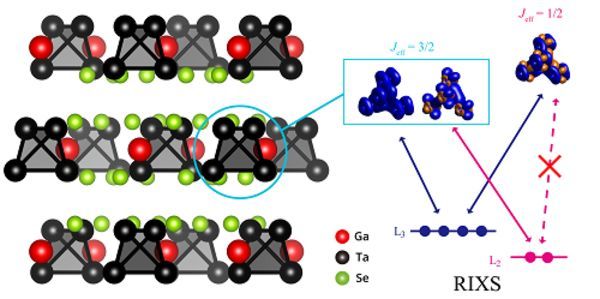
New Quantum Mechanical States Observed
"A KAIST research team observed a new quantum mechanical magnetic state ‘Jeff = 3/2.’ This first observation of ‘Jeff=3/2’ could be the foundation for future research on superconductivity and quantum magnetism. In quantum mechanics, total angular momentum is defined as the sum of spin and orbital angular momenta and is denoted with the ‘J.’ The newly identified magnetic moment can be described as a kind of angular momentum that occurs when specific conditions are met and has been denoted ‘Jeff’ with the meaning ‘effective angular momentum’ in the field. Jeff=3/2 has been a topic of discussion but was yet to be observed. The research was co-led by Professor Myung Joon Han of the Department of Physics at Chung-Ang University in Korea, RIKEN in Japan, and the Argonne National Laboratory in the US. This research was published in Nature Communications on October 14, 2017. In academia, spin-orbital coupling was known to lead to a unique quantum state and has been an active area of recent research." [...]

Scientists Discover Process for Transitioning Two-Layer Graphene into a Diamond-Hard Material on Impact
"The innovation could enable development of a range of flexible, impenetrable materials capable of protecting the body and fragile objects Imagine a material as flexible and lightweight as foil that becomes stiff and hard enough to stop a bullet on impact. In a newly published paper in Nature Nanotechnology, researchers across The City University of New York (CUNY) describe a process for creating diamene: flexible, layered sheets of graphene that temporarily become harder than diamond and impenetrable upon impact. Scientists at the Advanced Science Research Center (ASRC) at the Graduate Center, CUNY, worked to theorize and test how two layers of graphene — each one-atom thick — could be made to transform into a diamond-like material upon impact at room temperature. The team also found the moment of conversion resulted in a sudden reduction of electric current, suggesting diamene could have interesting electronic and spintronic properties. The new findings will likely have applications in developing wear-resistant protective coatings and ultra-light bullet-proof films. “This is the thinnest film with the stiffness and hardness of diamond ever created,” said Elisa Riedo, professor of physics at the ASRC and the project’s lead researcher." [...]
Documentação
A documentação é parte essencial do processo de aprendizagem e a Internet além de artigos interessantes de explorar também tem alguma documentação em formato PDF interessante de ler. Todos os links aqui apresentados são para conteúdo disponibilizado livremente pelo editor do livro.

The MagPI 65
"Raspberry Pi for Newbies The Raspberry Pi makes an amazing Christmas, present. And every year we welcome a huge number of newcomers. Raspberry Pi isn’t just a computer and a charity. We’re a community of people who love making stuff with programmable computers. So if you want to learn about digital making with Raspberry Pi, then you’ve found the right place. AIY Vision Kit For more regular readers… don’t worry!" [...]
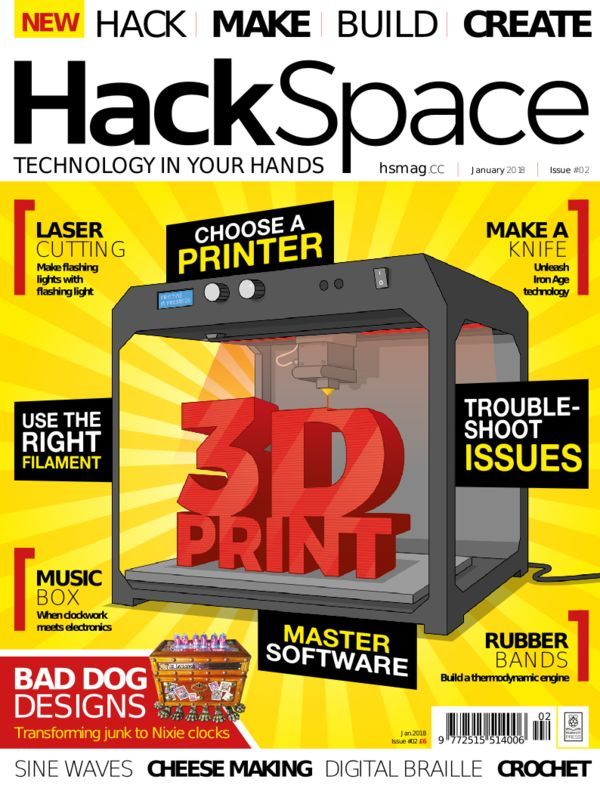
HackSpace magazine #2
"In HackSpace magazine issue two, we dive into the world of 3D printing, learn how Bristol Hackspace is helping Braille become more accessible, create the best looking goggles around, and uncover the art of the conference badge. - Press your own cheese - Design a customised Arduino - Laser-cut an LED clock - Make your own knife - and much more! " [...]
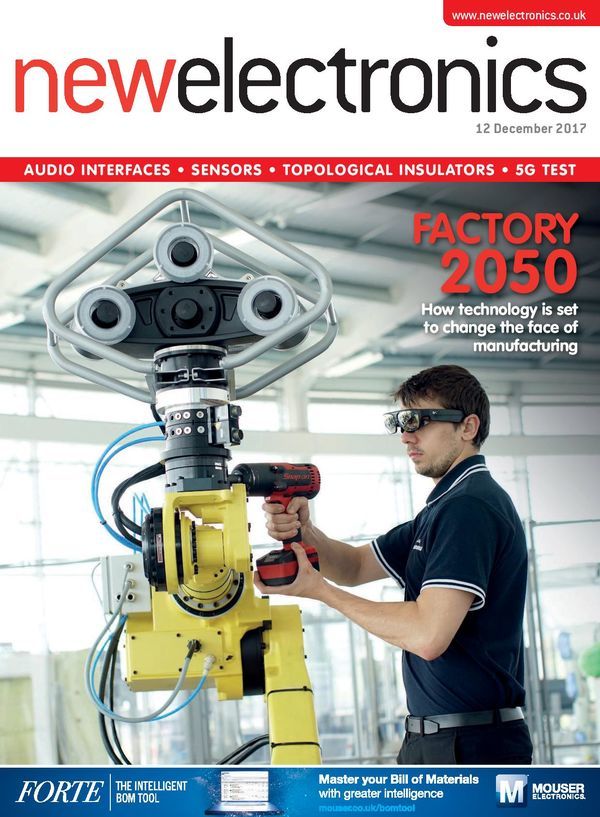
newelectronics de 12 Dezembro 2017
"New Electronics is a fortnightly magazine focusing on technological innovation, news and the latest developments in the electronics sector. Downloadable as a digital page turner or pdf file, or offered as a hard copy, the New Electronics magazine is available in a format to suit you. " [...]
Projetos Maker
Diversos Projetos interessantes.
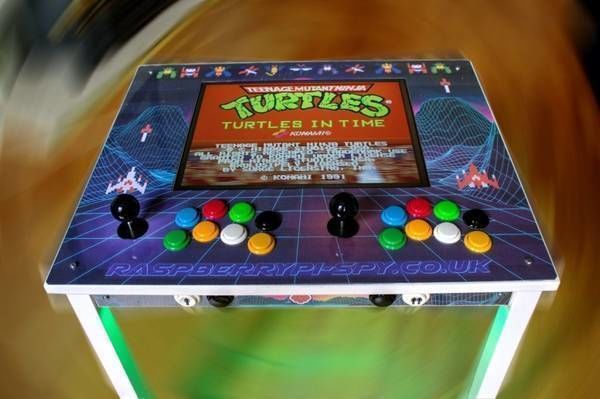
Building My Raspberry Pi IKEA Retro Arcade Table
"In a previous post I introduced my IKEA Arcade Table which is based on a Raspberry Pi 3 running RetroPie. I’m sure people might be interested in how I made it so I’ll go into a little bit more detail here. How I approached this project was heavily influenced by my own abilities, what tools I had available and what parts I was able to obtain or buy. For these reasons other people’s arcade table projects will look different. Hopefully this article will at least act as some inspiration for others even if it is not copied exactly. " [...]

Arduino Alarm Clock Relay
"I have a lot of trouble waking up early in the morning especially if I stayed up late the last night. Essentially this project allows you to open a relay at the time you set using the keypad and lcd.This relay can control many appliance from turning your tv or radio on to opening the window shutters in the morning. Lets begin ! " [...]
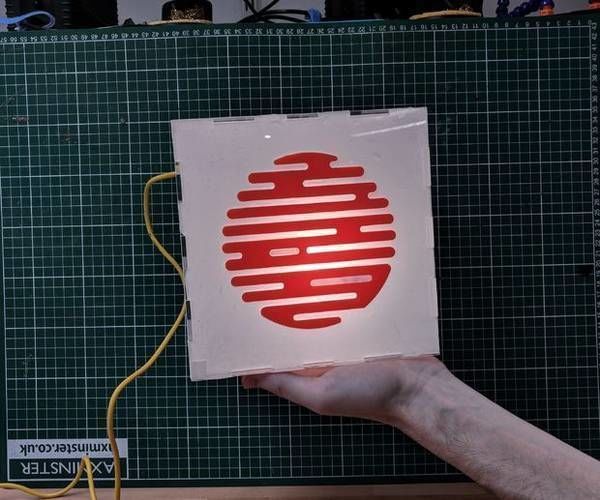
Sunrise Alarm Clock With Arduino
"Wintertime can be sad. You wake up, its dark and you have to get out of bed. The last thing you want to hear is the blaring sound of your alarm clock. I live in London and I have a hard time waking up in the morning. Also, I miss waking up to natural light. In this tutorial, we are going to build a Sunrise Alarm Clock." [...]

Unicycle LED Lightshow
"My kids are passioned for riding unicycle. Once the idea was born to add lights for a show event. Adding some lights would be already cool but inspired by other lightshows, the lights should be synchronized with the music. It was quite an adeventure but a great learning experience dealing with new items like LiPo, DMX, EL-wire, LED stripes, RF modules etc. The very first thought was to program everything into the control unit of one stripe. I have disregarded this because of two reasons: 1) With three actors (later will be 5), you are having 3x3=9 control units." [...]

Raspberry Pi Voice Navigation Helping Blind People
"Hi In this instructable we are going to see how a raspberry pi can help the blind people using the user-defined voice instruction. Here, With the help of the Ultrasonic sensor input to measure the distance we can voice guide the blind people to follow the path. Also, I am planning for the cheap module which could solve this problem guiding the way to the Blind people. This is the Idea to implement them in the raspberry pi, which is being the very tiny full-featured computer in our palms. I will also soon make a software in the ubuntu os, So that person without the technical background can make use of it help Blind people. " [...]
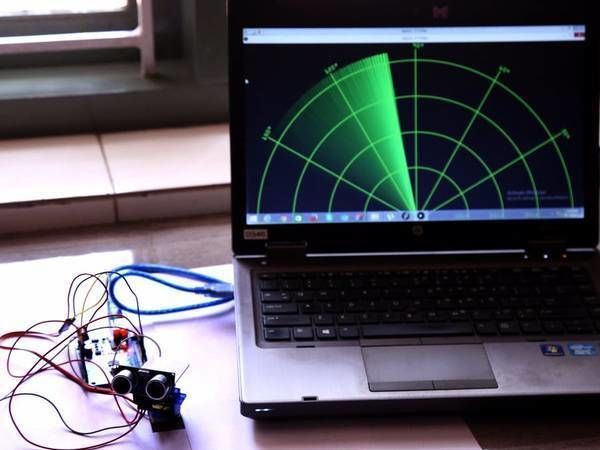
Arduino Based Radar System
"I have developed a visual experience of radar by processing ID with ultrasonic sensor, servo motor and Arduino. First I made a cardboard stand for connecting the Ultrasonic sensor to the Servo motor. I just screwed it on the servo motor as shown above Make the connections as shown in the schematics Upload the code to the Arduino Check the serial monitor whether the ultrasonic sensor is working or not (first one shows the servo rotating degree and the next one shows the distance measured by the ultrasonic sensors). Close the Arduino IDE Download the Processing IDE: https://processing.org/download/ Extract the zip file and install the software by clicking on the processing.exe file Paste the code given below into the Processing IDE" [...]

Arduino Keyboard Matrix Code and Hardware Tutorial
"As a kid, I got the book “Upgrading and Repairing PCs.” (Now in its 22nd edition.) It was the first book to explain to me the PC architecture. I considered, how were there so few pins on an AT-style keyboard connector when there were 101 keys on the keyboard? That is when I first learned about the keyboard matrix. The keyboard matrix itself did not amaze me, but instead the idea there was an entirely separate 8-bit microcontroller inside of the keyboard. Early keyboards may have used the P8049AH, which, there is still some stock available to purchase." [...]
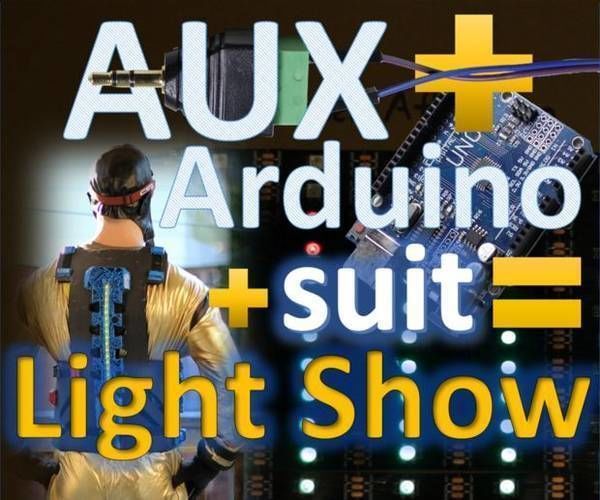
How to Make a Frequency Audio Visualizer for a Costume (Arduino Project)
"In this Instuctable, I will provide tips, plans, and codes to make an exciting audio visualizer built into a fiberglassed foam suit. Along the way I will share helpful steps and extra codes that some wanting to implement arduino FFT libraries into their projects could find valuable. " [...]
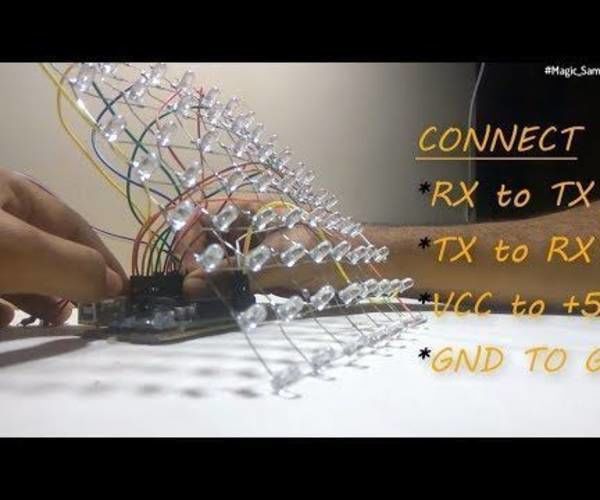
8x8 Led Matrix Display | Arduino | Bluetooth Control
"In this tutorial i show how to build a 8 x 8 LED matrix using an Arduino . have a look at the video tutorial for a better understanding of the entire tutorial. PARTS NEEDED: LEDS( 64 PCs) jumper wires cardboard piece(16 cm by 16cm) arduino uno laptop or pc (for uploading code to arduino power supply ( i used a power bank to save batteries)" [...]
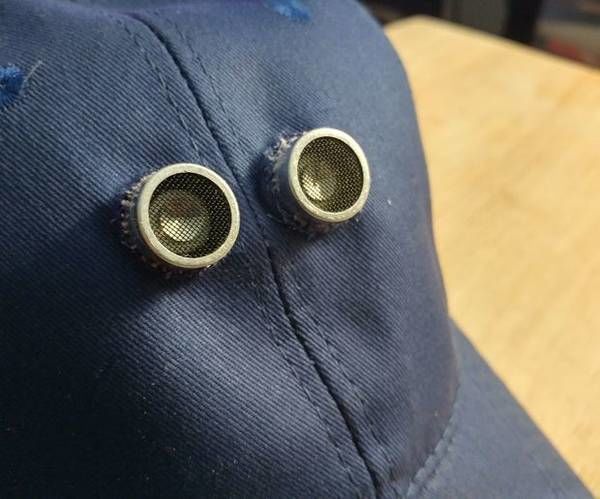
Proximity Hat
"Are you prone to hitting your head, like me. Even though I am below the average height I still hit my head a lot, especially when working on projects by leaning forward or lifting up and hitting my head. Because of this I decided to make a hat with a proximity sensor and alarm in it. I used some of the codes and settings from this other ultrasonic sensor instructable. https://www.instructables.com/id/UltraSonic-Proxim... Then added the code for an LED and modified it to fit in a hat. " [...]
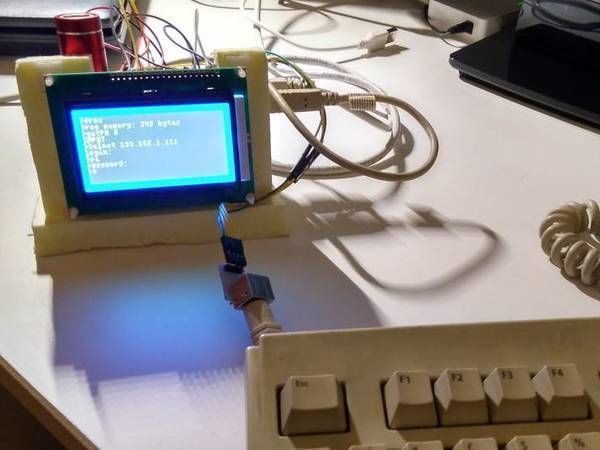
START: A STandalone ARduino Terminal
"Equipped with a keyboard, Ethernet Shield and LCD monitor, is able to execute built-in command and even to send command to a telnet server! START is a STandalone ARduino Terminal equipped with: a PS2 keyboard. an LCD monitor 128x64. an Ethernet port. optionally, a battery. START is able to execute a small set of built-in commands to control digital I/O and even to connect to a real telnet server to execute real shell commands remotely!" [...]
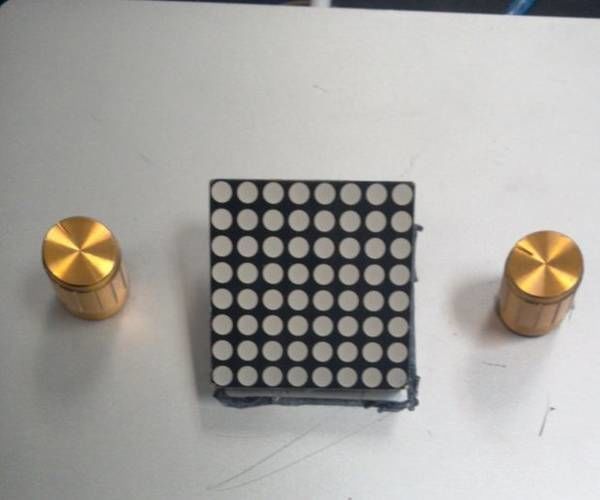
Pong on the Arduino by Pierson and Jace
"This is an instructable on how to play Pong on the arduino. It is told in five simple steps. We hope you enjoy our game! " [...]
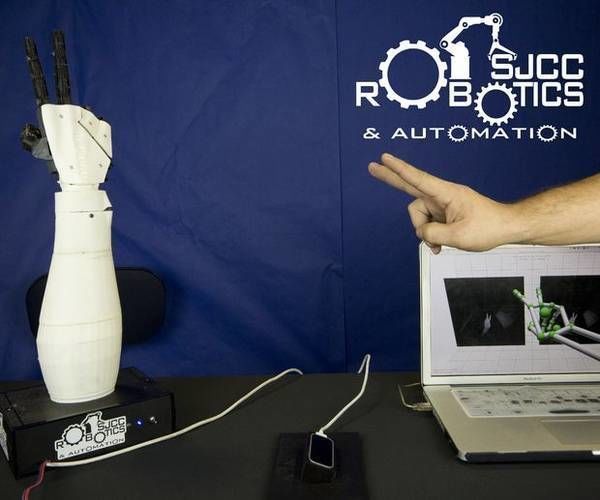
Robot Hand Control: Leap Motion, JavaScript, Node.js, and Arduino!
"Here we'll be building the InMoov robot hand and forearm and then learning how to control it using Leap Motion, JavaScript, Node.js, and Arduino. This is a barebones complete tutorial, so know that it does work. We'll be improving upon this over time adding lower level detail, assembly tips n tricks, etc. That being said, please enjoy! Thank you, SJCC Robotics & Automation Club December 2017" [...]
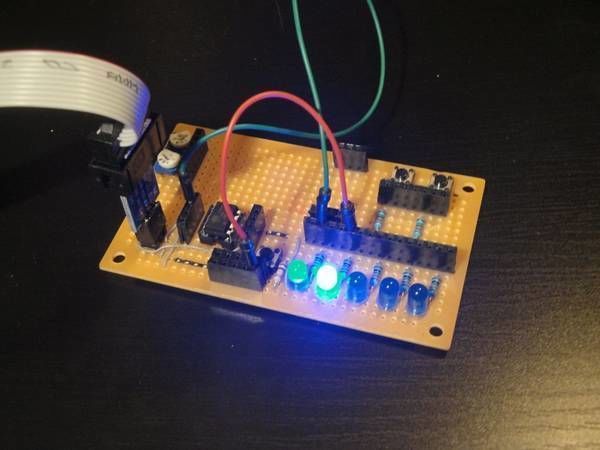
10-bit PWM from the ATtiny85
"The ATtiny85 microcontroller has two 8-bit timers. Using them can be controlled dimming of LEDs. 8 bit is not enough if you want to have a brightness change adapted to the human eye. Gamma correction causes visible jumps in brightness, especially at low brightness. The ATtiny85 microcontroller can with timer 1 produce even better resolution. In this article, we'll show you how to do it." [...]
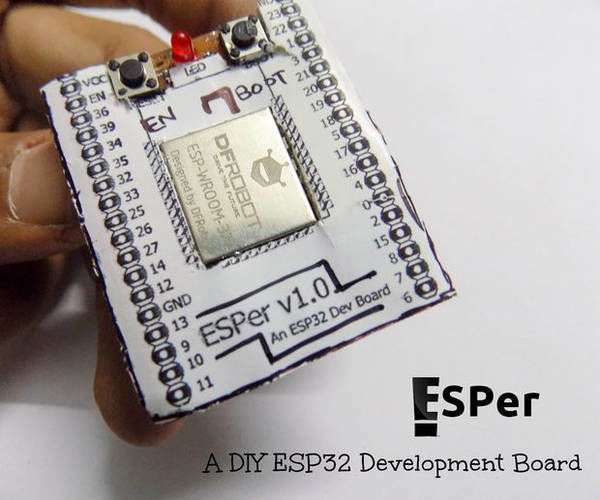
DIY ESP32 Development Board - ESPer
"So recently I had been reading about a lot of IoTs(Internet of Things) and trust me, I just couldn't wait to test one of these wonderful devices, with the ability to connect to the internet, myself and get my hands on work. Luckily the opportunity arose, thanks to DFRobot, and I was provided with ESP32, a powerful, hybrid and an awesome module. To begin with, I purposely asked the DFRobot team to send me the ESP32 module rather than the development board because I couldn't let the thrill of skillful get past my hands. And hence, here we are, making ourselves our own development board for ESP32. My main aims for this board were as follows: The development board must be breadboard-friendly. It must have EN(Reset) and FLASH tactile switches." [...]
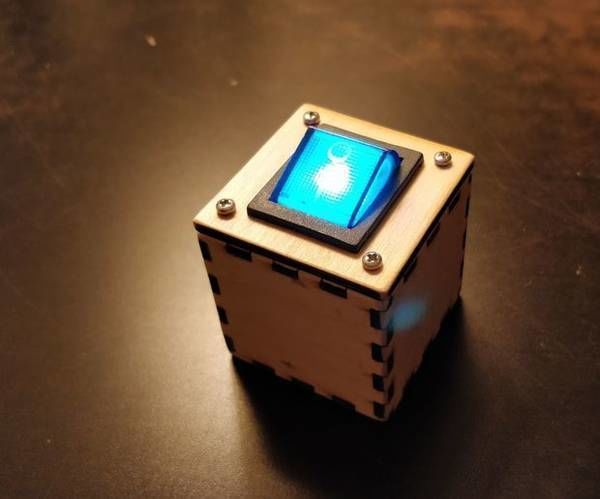
Busy Cube #1 - Simple Switch
"This specific project serves two purposes. First, I wanted something small and simple that will keep him entertained during plane and car rides. Second, I used it as prototype before making something more sophisticated (with a micro-controller, rechargeable battery, and all the other goodies). The design itself is simple - there's the cube structure itself (made of 6 pieces of plywood), and the on/off switch module. The later includes the switch, and two battery holders that are glued to it. This whole unit slides into the cube, and then secured with four small M2 screws." [...]
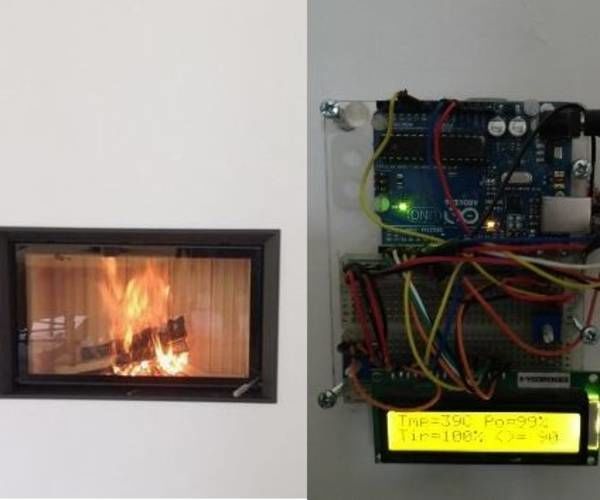
Wood Stove Regulator
"It is often tedious to control the air supply of a wood stove. I built an automatic regulator that do it for you. It controls the air supply depending of the temperatures of the chimney. The combustion is always optimal and you get the maximum calories out of your firewood. At the end of the fire, the system automatically close the air supply to prevent the stove to cool down to fast. WARNING : always let a minium drawing." [...]

Current Temperature on 8*8 LED Dot Matrix
"It shows the current temperature on an 8*8 dot matrix display using DHT11 temperature sensor. Here the current temperature is streamed on the 8*8 dot matrix LED display by scrolling using the DHT11 temperature sensor with Arduino Uno. We can see the current temperature in your bedroom when you wake up in the early morning. Need not look upon your mobile phone or computer. The temperature shown is very accurate. Here the temperature is sensed by the DHT11 sensor, processed by the Arduino and it is shown on the LED matrix with a scrolling display." [...]

The Pocket Sized Retro TV
"This guide shows you how to make and setup a retro-looking TV, with a Raspberry Pi, a Touchscreen and some 3D printed parts. " [...]
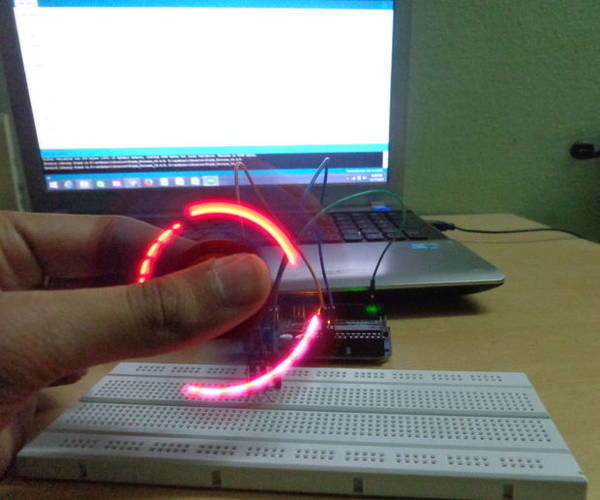
Hall Effect Sensor on Arduino Using Fidget Spinner
"Abstract In this project I am explaining about how hall effect sensor works measuring fidget spinner speed with arduino board. working:- A Hall effect sensor is a transducer that varies its output voltage in response to a magnetic field. Hall effect sensors are used for proximity switching, positioning, speed detection, and current sensing applications. ... In its simplest form, the sensor operates as an analog transducer, directly returning a voltage. Applications:- 1." [...]
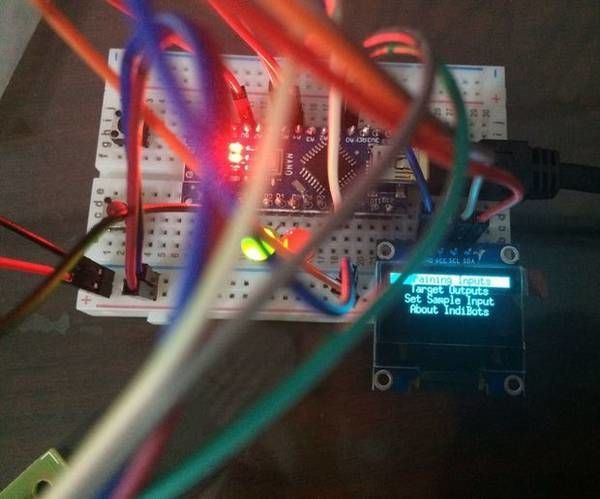
Arduino-Nano and Artificial Neural Networks
"Hi Friends, Here is an implementation of Artificial Neural Networks (ANN) on Arduino Nano board, that I have done recently. The steps below will explain how a sample ANN program can be trained to learn the XOR truth table outputs very efficiently. This can further be extended to any truth table . Thanks to these resources I have referenced and they are so amazingly easy to learn. Check these for your reading! ANN for Arduino : http://robotics.hobbizine.com/arduinoann.html" [...]
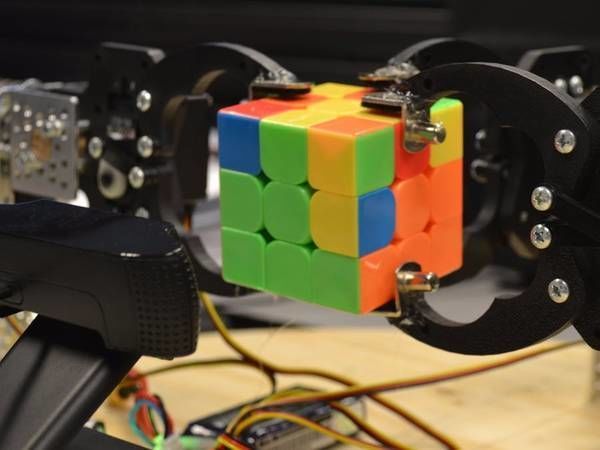
Robotics w/ OSD335x-Powered BeagleBone Blue: Rubik's Solver
"Experience the OSD335x performance for industrial applications & robotics by building this cool Rubik's Cube solver using BeagleBone Blue. Building the Rubik's Cube Solver with OSD335x System-In-Package Our team was challenged to build a portable robot to demonstrate that the OSD335x System-In-Package can address the needs of industrial control, automation and robotics applications. For the full story and more information about the design go to our blog: Industrial Control Exemplified: An OSD335x Powered Rubik’s Cube Solving Robot" [...]
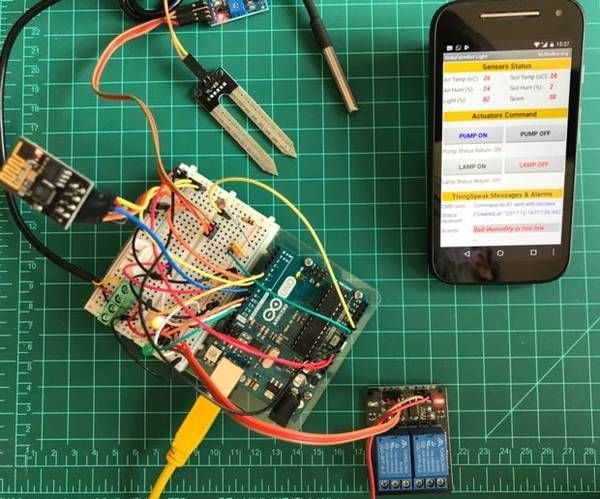
IoT Made Easy With UNO, ESP-01, ThingSpeak and MIT App Inventor
"This Instructable is competing on contests: "Remote Control", and "Arduino", If you like it, please give your vote by clicking at the above banner. Thanks a lot! ;-)The great majority of my work on IoT arena was using NodeMCU and more recently, the ESP32. But, I think important not forget my early steps, a couple of years ago where I start learning IoT using an Arduino UNO and the old and good ESP8266-01. So, I decide here to return to that time (with a little bit more of experience now) and explore again those great devices, connecting them to the cloud, using the ThingSpeak.com web service. We will also explore to control things remotely, be using an Android App developed using the MIT AppInventor." [...]

The Mini Wall: the Electronic Game
"Idea: Colyne, our 5 year old daughter, is a fan of the TV game show "The Wall" on NBC (TF1 in France), so for her birthday I decided to build a miniature table version. Made of wood, the game consists of a tray with 200 nails where the balls pass. A LED matrix display shows the different steps and points. The system is controlled by an Arduino Nano and powered by a USB (5V). In this Instructable, you will find the plans, Arduino code, schema, background image ... Video: Operation: at the start, we choise the number of players (1 to 9), the game takes place in 7 rounds, In each round, players receive between 1 and 3 balls (automatic distribution) and the LEDs light up in green or red, the player places the ball (s) in the desired position (1 to 7 at the top) and activates the start (by lowering the blue lever on the right or left side) the balls fall and the score is counted (in + if green and - if red) and displayed on the screen - At the end of the 7 rounds, the winner is displayed along with all scoresTime spent: 50H (+ almost as much for study and programming)Cost: about 60 Tools used: Circular saw, mini saw, drill, screwdriver, ripper, glue gun, hand tools ..." [...]
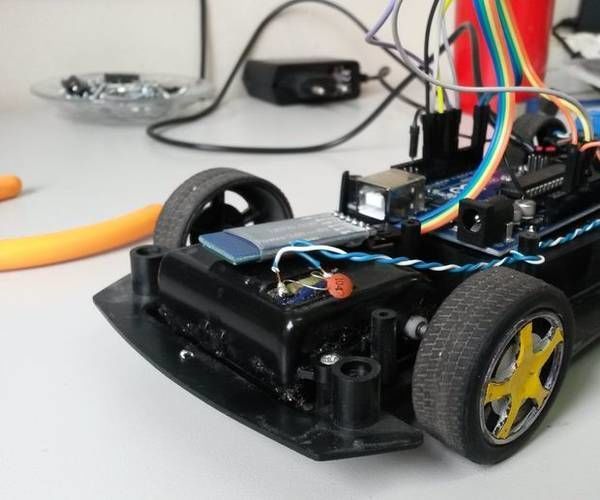
Arduino Bluetooth Car Control
"Arduino - Bluetooth Car Control Project Application steps:1. Install Arduino Bluetooth Car Control Application from below link: https://play.google.com/store/apps/de... 2. Download Connection schemmatic, insallation steps .and Arduino .ino code from link: https://drive.google.com/drive/u/0/folders/0B8lboyisdqhBU0EtdEl3RExGdmc 3. Connect your devices. (It's explain at below) 4. Download Arduino .ino code to your Arduino Uno card." [...]

Measuring DC Voltage With Arduino and Node-RED
"There are a lot of tutorials DC voltage measurement with Arduino, in this case I found a tutorial that I consider the best functional method to measure DC without requiring input values of resistance, only requires some resistance and a multimeter, In next tutorials we will start with solar panels and we need to measure VDC over long periods. The code was taken from startingelectronics.org of the article Measuring DC Voltage using Arduino thanks for the great contribution. Source: Measuring DC Voltage using Arduino We made some modifications but added a visualization and the result was very good ! !Our arduino measures the voltage in the battery and transmits via serial to Node-RED. " [...]

ESP8266/ESP-01 Arduino Powered SmartThings Leak Detector
"Sooooo Many leak detectors to choose from, which one will work best for you? If you have Samsung SmartThings controlling any devices in your home, then this one might just be the ticket! This is the final version in a series that I've been building around the ESP8266/ESP-01 controller powered by Arduino. We all know that the more mature siblings of the ESP-01 like the NodeMCU ESP12's, etc...are much easier to work with, but this was a mission to show off the power of the little ESP-01 which I am still very fond of. It was my first ESP8266!! To see the previous versions in this little 'Leak Detector How-To' series, please take a look at the Instructables below." [...]
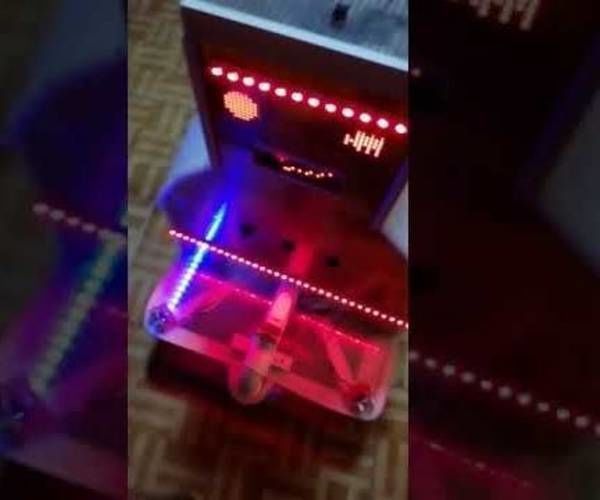
An Autonomous Robot With Many Capabilities
"Hi friends, in this instructable I am going to introduce a new version of my previous instructable that can do the following tasks: 1- It can move autonomously by Arduino UNO and L298N motor driver 2- It can do cleaning as a vacuum cleaner 3- It can play songs by Bluetooth 4- It can change the states of its eyes and mouth by Arduino 5- It has flashing LED 6- Its eyebrow and its skirt 's margin is made of strip LED So this unique instructable is a very good class for those who want a simple but multi functioned robot. I must add, many features of this robot is taken from articles in Instructables site and I am acknowledging this by quoting the article in every relevant section. " [...]
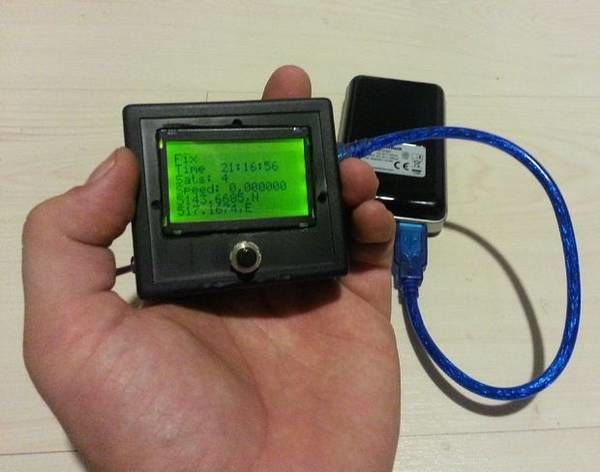
Compact Arduino GPS Speedo + and More
"So I decided to build an device I could use in my car, a GPS speedo looked like a good idea.The Parts I used in this build: -(fake) Arduino Nano v3 ($10,99). -MT3339 GPS module. -Graphic LCD + Connector ($5,00). -Plastic enclosure ($4.58). -1 x 6 pin switch. -1 x Push button." [...]
Tiny UHF Tracker Transmitter
"This is a little circuit that could be used to track an object up to 400m. It is essentially an SAW stabilized OOK modulated RF transmitter. The modulation is done with two low frequency ultra low power oscillators that activate the transmitter every two seconds for a short period. With the setup shown here I got up to 400m range. Current consumption is about 180uA average so it'll work for a couple of days with the little button cell. Frequency 915MHz." [...]

How to Make Simple Weather Station Using Arduino
"Hello Guys, In this Instructable I will explain how to make simple weather station to sense temperature and humidity using DHT11 sensor and Arduino, the sensed data will be displayed on LCD Display. Before starting this instructable you must know some information about the DHT11 sensor. Lets Gets started...." [...]

Arduino Indoor Doorbell
"So I wanted to test out the capabilities of some basic RF transmitter/receiver modules for the Arduino and, after going through this awesome tutorial, I decided to create a small project. In this instructable, I am going to show you how to create a simple, wireless doorbell that plays a given melody. Why, you ask? Well, I noticed that, whenever someone (in that case parents) calls me for dinner, it is so quiet that I do not even notice that someone shouts my name. Since I do not check my phone so often, writing me a SMS does not do it either. I decided to stop that by creating an indoor doorbell, so whenever someone needs me downstairs, pressing a button is all that person has to do." [...]

DIY - Dancing Android Robot
"The people who use it or even those who don't, know that android is a wonderful mobile operating system. Google has also designed a droid as a symbol for this wonderful OS. I noticed that the market is flooded with toys that resemble an android robot. In this Instructable, i decided to make an Android robot with some usual stuff i had (like cardboard and motor). I also decided to give it some random movements. After designing this android robot, it came out so well and it makes such wonderful moves that it just feels as if its a simple dancing android robot." [...]
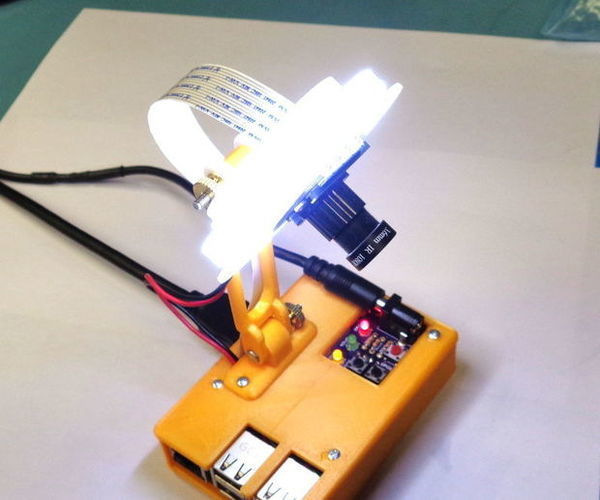
RPi MacroScope
"The Raspberry Pi, combined with an adjustable focus camera, can be used to help us better observe the world between microscopic and the un-aided eye. I primarily use this for photographing electronic assembly (including all the pictures in this Instructable), but it can also be used to take videos and create timelapses. The addition of a foot pedal allows for hands-free camera work. Images can be stored on a USB thumb drive, or to the expanded Fat32 formatted section of the Pi's SD card so it can be removed and read on a Windows computer. This project is quite involved, but has three separate aspects that can be utilized independent of the others: PiFet: A circuit board containing circuitry to control the LED light ring and provide user input via push buttons. Case: A 3D printed case and camera mount." [...]
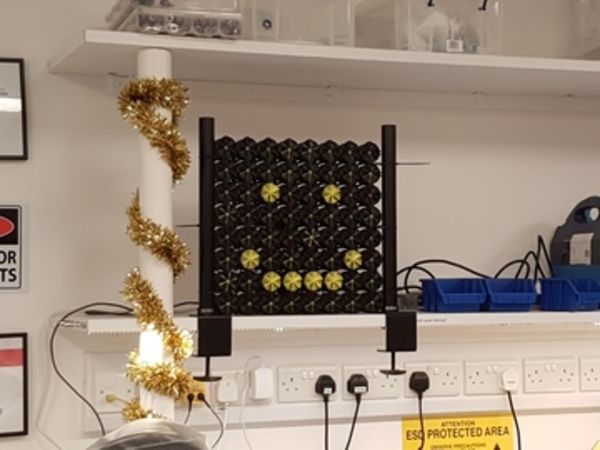
Electromechanical display
"Background I wanted to do something special for this year’s office xmas party. Several people were playing with LEDs and it got me thinking about different ways to display an image. I quite liked the idea of a retro look and feel using electromechanical elements, but didn’t want to just replicate one of the more popular methods like flip discs. I thought about ways in which a colour could be revealed and eventually came up with a way using rotation to move one piece in front of another. " [...]

Snowman Led Mirror Sign
"In this instructable I am going to describe how you can make an led edge lit glass mirror with a Snowman design, perfect for Christmas! The sign is engraved on a glass mirror tile from Ikea. These come in packs of four and are quite cost effective. I have used a Dremel 290 tool for the engraving but there are lots of other methods that can be used, e.g. cnc router, chemical etching or sandblasting. Another option is to use a Dremel drill or other rotary tool and an engraving bit." [...]
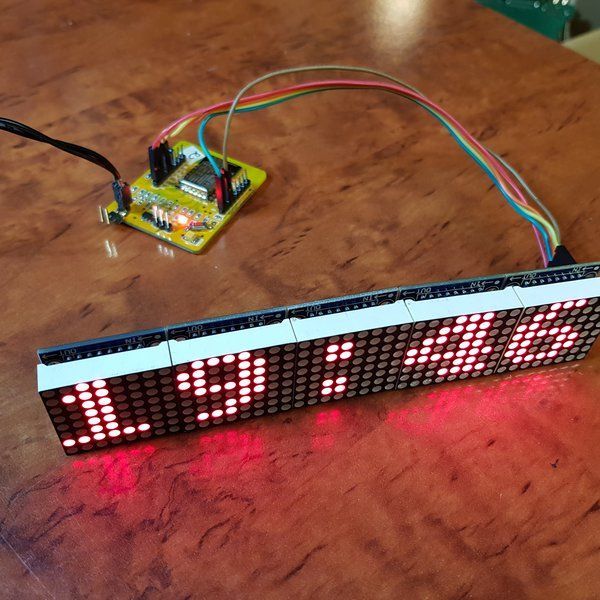
ESP8266 MAX7219 Dot Matrix Display as MQTT Client
"A MAX7219 driven Display, controlled by an ESP8266 SoC and MQTT This project describes how to connect a MAX7219 to an ESP8266 Chip and let it act as a MQTT client. Its basically my ninHOME Node Firmware where you can optionally add a MAX7219 Display. The Firmware is completely based on Sming Framework for ESP8266 and is hopefully easy to use. I will upload some binaries which you can upload without the compiling. Formerly i use this firmware and its options for my SmartHome integration with ioBroker from where I script everything i want to control or measure. And it isn't completely ready, so if you want to contribute something ..." [...]
That's all Folks!


